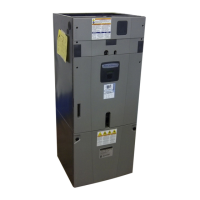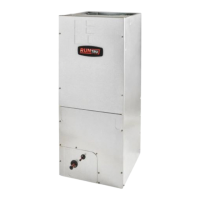CLCH-SVX07C-EN 127
Routine Maintenance
Individual coil types determine how to properly winterize the coil. To determine the coil type find
the “Service Model No of Coil” on the coil section nameplate. The coil type is designated by the
second and third digits on that model number. For example, if the model number begins with
“DUWB,” the coil type is UW; if the model number begins with “DW0B,” the coil type is W.
Note: On many unit sizes, there are multiple coils in the coil section. Be sure to winterize all coils
in a given coil section.
Type D1, D2, WL, LL, UA, UW, UU, W, P2, P4, P8, WD, 5D, and 5W Coils
Note: Use care in removing header plugs from Type P2, P4, and P8 coils. Over-torquing may result
in twisted tubes.
1. Remove the vent and drain plugs.
2. Blow the coil out as completely as possible with compressed air.
3. Fill and drain the coil several times with full strength glycol so that it mixes thoroughly with the
water retained in the coil.
4. Drain the coil out as completely as possible.
5. To ensure no water remains in the coil, do not replace the vent and drain plugs until the coils
are put back into service.
Moisture Purge Cycle
By it’s very nature, any HVAC unit with a cooling coil serves as a dehumidifier, reducing the
surrounding air’s ability to hold water vapor as its temperature falls. This normally doesn’t present
a problem when the unit is running. However, when the fan stops, water vapor condenses on the
cold metal surfaces inside the air handler and remains there until the air warms sufficiently to re-
evaporate it. This damp, dark environment—though temporary—can encourage the growth of
mold, mildew, and other microbial contaminants.
Providing a moisture purge cycle 15 to 30 minutes after shutdown disperses the cold, humid air
inside the air-handling system more evenly throughout the building. This four-step cycle:
• Closes the outdoor air dampers.
• Turns off the cooling coil.
• Opens any variable-air-volume terminals connected to the air handler.
• Operates the supply fan for 10 to 15 minutes.
Air movement discourages water condensation and hastens re-evaporation of any condensate that
does happen to form. This simple preventative measure effectively combats microbial growth and
curbs moisture-related deterioration of air-handling components.
Cleaning Non-Porous Surfaces
WARNING
Hazardous Voltage!
Disconnect all electric power, including remote disconnects before servicing. Follow proper
lockout/tagout procedures to ensure the equipment cannot be inadvertently energized. Failure
to disconnect power before servicing could result in death or serious injury.
If microbial growth on a non-porous insulating surface (closed cell insulation or sheet metal
surface) is observed:
1. Disconnect all electrical power to the unit.
2. Wearing the appropriate personal protective equipment, use a brush for sheet metal surfaces
or a soft sponge on a foil face or closed cell foam surface to mechanically remove the microbial
growth.

